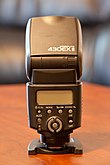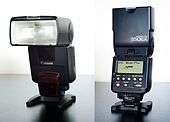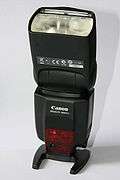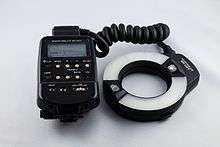Canon EOS flash system
Canon's EOS flash system refers to the photographic flash mechanism used on Canon's film (35mm and APS) or digital EOS single-lens reflex cameras. The line was first introduced in 1987. It has gone through a number of revisions over the years, as new flash exposure metering systems have been introduced. The main light-metering technologies are known as A-TTL, E-TTL, and E-TTL II.
The EOS flash system is capable of wireless multiple flash control, whereby a master flash unit IR (ST-E2) or RF (ST-E3-RT) transmitter mounted on the camera body can control up to 3 (optical) or 5 (radio) groups of flash units. The Canon EOS 7D is the first Canon body to be able to control Speedlites wirelessly without the use of a Master Speedlite or IR transmitter; four other EOS models, the 60D, 600D, 650D, 70D, and 700D, also have wireless flash capabilities. The 7D is capable of handling three slave groups. The other cameras can handle two slave groups.
Metering systems
Canon has introduced several different metering systems for its flash products: A-TTL, E-TTL, and E-TTL II. Each system represents different approaches to achieving the proper flash exposure.
A-TTL
Advanced-Through The Lens (A-TTL) is a through-the-lens (TTL) metering system that was expanded to support flashes. A sensor inside the camera reads the amount of light being reflected off the film during the exposure. When the sensor determines that the exposure is sufficient, it terminates the flash pulse. A-TTL, first seen on the T90 (which predates the EOS family), is a flash exposure system that adds a brief preflash during exposure metering when the camera is in the programmed exposure (P) mode. The amount of light returned from this preflash is used to determine an appropriate tradeoff between aperture and shutter speed in P mode. Depending on the specific flash unit and whether or not it is set to bounce, the preflash might be infrared or it might be the normal white flash. In an A-TTL system the sensor that reads the preflash return is located on the flash unit; this caused some issues especially when using filters as the filter would cover the lens (but not the sensor outside the lens) thus causing inaccurate settings. Some early Canon EOS cameras also used the A-TTL preflash in non-programmed exposure modes to detect "out of range" conditions; the "out of range" warning feature was dropped on later models, reportedly due to patent conflicts.
E-TTL
Evaluative-Through The Lens (E-TTL) is a Canon EOS flash exposure system that uses a brief pre-flash before the main flash in order to obtain a more correct exposure. Unlike TTL and A-TTL metering, which use a dedicated flash metering sensor mounted in the base of the mirror box, E-TTL uses the same evaluative metering sensor used for ambient metering. Like TTL (and like the actual flash metering, but not the pre-flash, of A-TTL), the sensor is internal to the camera and takes its exposure via the lens so any filters added to the lens will also affect the E-TTL readings giving more accurate exposure information to the camera.
The pre-flash occurs immediately before the main flash (except when using the camera / flash in 2nd curtain sync mode) and is barely perceptible, although it can be seen if you watch carefully for it. The pre-flash may cause undesirable reactions from animate objects - e.g. humans may blink as a reaction to the pre-flash, and have their eyes closed by the time the main flash occurs. When using flash exposure lock (FEL), the pre-flash is fired when FEL is activated.
E-TTL II
E-TTL II is a software improvement on E-TTL and is now a standard in all EOS cameras introduced with or after the Canon EOS-1D Mark II in 2004. E-TTL II is implemented in the body, not the flash unit, and therefore can use existing E-TTL flash units and EF lenses.
The main improvement of E-TTL II is that it gives a more natural flash exposure, by being able to handle tricky scenes where the old E-TTL system would normally be thrown off. Such improvements are possible because E-TTL II incorporates lens-to-subject distance information in its calculation, where available, to assist in determining an approximate guide number for flash output. The flash metering system is also no longer linked to the AF system, whereas in the old E-TTL metering, bias is given to the selected AF point. Rather, E-TTL II compares the ambient and the pre-flash light levels of the scene to determine where the subject lies, in conjunction with subject distance information if available. This gives the photographer the flexibility to lock focus and recompose the scene without fooling the flash metering system. 'Hotspots' (areas of high reflectance) that would normally throw off the flash metering system are also ignored in the calculation.
Speedlite products
Speedlite is the trade name for Canon's line of external flashes for use with their EOS line of cameras.[1] It is similar but not to be confused with Nikon Corporation's "Speedlight" brand for their flashes. The Speedlite name is also used by Ricoh for its unrelated product line of flash units, such as the Ricoh Speedlite 202.
The brand names are intended to indicate that strobe flashes produce much shorter and more intense bursts of light than earlier photographic lighting systems, such as flashbulbs, or the continuous lighting used in some studio situations.
90 series flashes
90 EX
Introduced in autumn 2012, the Speedlite 90 EX is a very small unit designed specifically for the company's first mirrorless interchangeable-lens camera, the EOS M. It runs off two AAA batteries, and can serve as a wireless flash controller. At introduction, the 90 EX was bundled with all EOS M kits sold in the EU, though not in the U.S.[2][3]
200 series flashes
220 EX
Introduced in 2000, Speedlite 220 EX is a compact entry-level flash unit with a guide number of 22 m (at ISO 100). It operates with four AA batteries, and does not feature any wireless capabilities.
270 EX and 270 EX II
Speedlite 270 EX (introduced in March 2009[4]) and 270 EX II (introduced in February 2011[5]) are compact entry-level flashes with a guide number of 27 m (ISO 100).
270 EX features a zoom head which covers 28–55 mm lenses and bounce head capability. 270 EX II adds wireless slave mode and remote shutter triggering.
300 series flashes
320 EX
In 2011, Canon introduced a new flash that has a built-in LED light. One reviewer noted that the flash occupied a completely new niche in the Canon flash lineup, "slotting between the 270 EX II and the 430 EX II", and added that it did not replace a previous model.[6]
The LED can be used as a spotlight to see objects in dim light before taking a photo,[7] but is mainly present to provide fill light for video shooting.[6] The aforementioned reviewer also stated that the LED could be used in some situations as a substitute for a standard flashlight.[6]
380 EX
This unit is very similar to 430EX in terms of E-TTL functions and power levels. It does not feature an LCD screen like 400 series systems but has several LEDs indicating zoom position and other functions. It is the first E-TTL unit from Canon sold as a dedicated flash for the first E-TTL cameras - EOS 50 (Elan II) and EOS 50e (Elan IIe), which were introduced in 1995.
400 Series Flashes
Canon's external flashes with model numbers in the 400 range tend to be their mid-range external flashes. They all tend to have the ability to adjust the direction of the flash via a swivel head, which allows the photographer to bounce the flash off walls, ceilings, and other objects, diffusing the light that hits the subject and reducing the harsh shadows associated with on-camera flash. The 400 series differs from the higher end 500 series mostly by lacking a remote controller.
420 EX
The Speedlite 420EX is an external flash formerly made by Canon. The Speedlite 420EX is one of Canon's older mid-range flashes, being replaced by the 430EX in 2005. It was primarily intended for users wanting to step up from the entry-level flashes, as well as for use as a slave flash along with the more advanced Speedlite 550EX flash.
Compared to its predecessor, the 380EX, it provided slightly more power, an improved autofocus assist beam, tilt and swivel (the 380EX could only tilt), and the ability to serve as a slave in Canon's wireless multiple-flash system.[8] Like the 380EX, the 420EX did not provide user controls (other than enabling and disabling high-speed sync); any flash-related settings, such as exposure compensation or second-curtain synchronization, had to be set using the body.
Its autofocus assist system was designed to cover Canon's autofocus layouts with between 1 and 7 autofocus points; it was not designed to cover the 45-point autofocus layout used by higher-end bodies. It used two lamps to project horizontal and vertical patterns, which matched the line sensitivity of the autofocus sensors used in those autofocus layouts. Either or both patterns would be projected depending on the body being used and the user's selection of autofocus sensor(s).
430 EX, 430 EX II and 430EX III-RT


The Speedlite 430EX[9] and Speedlite 430EX II[10] are external flashes made by Canon for use with their EOS line of cameras. The 430EX II is meant to succeed the 430 EX and was announced on June 10, 2008,[11][12] while the Speedlite 430EX was first announced on 22 August 2005.[13] The flashes can be used as a wireless slave unit with Canon Speedlite Transmitter ST-E2 or top-of-line flashes with built-in infrared controller, such as Speedlite 550EX, Speedlite 580 EX or Speedlite 580EX II.
The flash head can swivel up (to 90°), right (to 90°) and left (to 180°).[14] The swivel properties allow the photographer to bounce the flash off walls, ceilings, and other objects, diffusing the light that hits the subject and reducing the harsh shadows associated with on-camera flash.
Both flashes support TTL, E-TTL, and E-TTL II flash metering and have Guide Numbers of 141 ft/43m (at ISO 100 and 105 mm).[9][10]
The Speedlite 430EX II improved on its predecessor by adding a stronger, all metal foot with quick release mechanism, silent flash recycling, 20% shorter recycle times and support for setup through the camera's menu system.
The Speedlite 430EX III-RT was announced in July 2015 and is expected to ship in September 2015.[15]
470EX-AI
The Speedlite 470EX-AI is an external flash made by Canon for use with their EOS line of cameras that was announced on February 25, 2018. It is Canon's first flash to feature AI Bounce, which "determines the optimal bounce angle and swivels into position to capture the appropriate camera exposure and flash output."[16]
500 and 600 series flashes
Canon's external flashes with model numbers in the 500 and 600 ranges tend to be their high end external flashes. All three products so far have included a controller that enables wireless control of other flashes. Another common feature is the ability to adjust the direction of the flash via a swivel head. The swivel properties allow the photographer to bounce the flash off walls, ceilings, and other objects, diffusing the light that hits the subject and reducing the harsh shadows associated with on-camera flash.
550 EX

The Speedlite 550EX (introduced September 1998) is a flash made by Canon for use with their EOS line of cameras, primarily the Canon EOS 3. The 550 EX can act as a controller that enables wireless control of other flashes.[17] Until the release of the Speedlite 580EX in late 2004, the 550EX was Canon's top-of-the-line flash.
580 EX and 580 EX II
The Speedlite 580EX[18] and Speedlite 580EX II[19] are flashes made by Canon for use with their EOS line of cameras. The 580 EX was succeeded by the Speedlite 580EX II in early 2008. The flashes in the 500 EX series can act as a controller that enables wireless control of other flashes. They also have a slightly stronger maximum flash output and a more durable casing than 430EX units.

Key features of the 580 EX II that make it desirable are a built-in PC terminal, easy locking metal foot, faster recycling time, silent charge, a much easier-to-use battery cover and support for setup through the camera's menu system.[20][21]
The unit is also fully sealed against moisture and weather conditions with silicon gaskets all around. However some better features on the earlier model were dropped like EL backlight on the LCD (580EX II uses simple led back-light) and designated master/slave switch. Both units are made in Japan.
None of the 580EX variants is available in the Canon store nor the Canon product pages in 2016, suggesting they are both discontinued.
600 EX-RT and 600 EX II-RT
The Speedlite 600EX-RT[22] was announced on March 2, 2012 alongside the new Canon EOS 5D Mark III.[23] The 600 EX-RT features new bi-directional 2.4 GHz wireless radio communication, compatible with the also-announced Speedlite ST-E3-RT transmitter; as well as backwards compatibility with the optical triggering of any combination of Speedlite 580EX II, 580EX, 550EX, 430EX II, 430EX, 420EX, 320EX, or 270EX II flashes.
Both the 600EX-RT and ST-E3-RT may be subject to legal restrictions of use when in their Radio Transmission (RT) mode. Official Canon documentation accompanying these units, "Regions of Use and Restrictions", lists 58 countries where the units do comply with local radio wave regulations. Countries that are not listed include: the Republic of South Africa, Israel, Argentina, Pakistan, to name but a few. Customers are advised to "not use this product in areas it was not designed for".[24]
The 600 EX II-RT (June 2016) improved on flash firing among other features.[25]
ST-E2 transmitter


The Speedlite Transmitter ST-E2 is a camera-mounted infrared controller for Canon's flashes.[26] It allows for multiple off-camera flashes to be fired in E-TTL mode without the need for connecting wires.[27]
Flashes being triggered by the ST-E2 can be assigned to either group A or group B, and the ST-E2 can be configured to with a user-set ratio of flash output between the two groups, with ratios varying from 8:1 to 1:8 in half-stop increments.
High-speed sync is also supported by the ST-E2, but it does not support second-curtain synchronization or stroboscopic flash.
A built-in focus assist light allows the ST-E2 to be used to help a camera focus in very low light.
The Speedlite 550 EX, 580EX, 580EX II and the 600 EX-RT flashes (when used as a master flash) use modulation of the pre flash from the main flash tube for communicating with slave flashes. The ST-E2 also uses a modulated flash tube for this purpose, but it is fitted with a near infra-red filter (it serves no other purpose). It has a quoted range of 10-15m indoors, and 8-10m outdoors.
The ST-E2 uses a single 2CR5 lithium battery, which is said to be good for 1500 transmissions.
ST-E3-RT transmitter
The Speedlite ST-E3-RT[28] was also announced on March 2, 2012.[23] It features a new bi-directional 2.4 GHz wireless communications with a range of 30m, but is only compatible with the also-announced Speedlite 600EX-RT flash and the upcoming Speedlite 430EX III-RT. The ST-E3-RT does not have a focus-assist light, but now uses more commonly available AA batteries, and supports high-speed sync.
Macro flash products

Canon currently produces three flash products for macro photography
Model specifications
| Model | 600EX II-RT[33] | 600EX-RT[34] | 580EX II[35] | 580EX[36] | 430EX III-RT[37] | 430EX II[38] | 430EX[39] |
|---|---|---|---|---|---|---|---|
| Release date | June 2016 | March 2012 | February 2007 | August 2004 | September 2015 | June 2008 | August 2005 |
| Item codes | 5296B002 | 1946B002 | 9445A002 | 2805B002 | 0298B002 | ||
| Retail price (US) | $580 | $550 | $300 | ||||
| Max. guide number (ISO 100) | 60 metres (200 ft) | 60 metres (200 ft) | 58 metres (190 ft) | 58 metres (190 ft) | 43 metres (141 ft) | 43 metres (141 ft) | 43 metres (141 ft) |
| Swivel range | 360° | 360° | 360° | 360° | 330° | 270° | 270° |
| RF (radio frequency) | Master & Slave | Master & Slave | No | No | Master & Slave | No | No |
| IR (infrared) | Master & Slave | Master & Slave | Master & Slave | Master & Slave | Slave only | Slave only | Slave only |
| Accepts external power | Yes | Yes | Yes | Yes | No | No | No |
| Weight (without batteries) | 435 grams (15.3 oz) | 425 grams (15.0 oz) | 375 grams (13.2 oz) | 375 grams (13.2 oz) | 295 grams (10.4 oz) | 330 grams (12 oz) | 330 grams (12 oz) |
| Predecessor | 600EX-RT | 580EX II | 580EX | 550EX | 430EX II | 430EX | 420EX |
| Notable features over predecessor | RF, slightly greater flash range, self-cleaning shoe | quick-release clamp, slightly faster cycling time, menu setup support, weather resistant sealing, silent charge circuit | quick-release clamp, slightly faster cycling time, menu setup support |
| Model | 320EX[40] | 270EX II[41] | 270EX[42] | 90EX[43] | MT-24EX[44] |
|---|---|---|---|---|---|
| Release date | February 2011 | February 2011 | March 2009 | July 2012 | |
| Item codes | |||||
| Retail price (US) | $239.00 | $169.00 | |||
| Max. guide number (ISO 100) | 32 m (105 ft) | 27 m (89 ft) | 27 m (89 ft) | 9 m (30 ft) | 22 m (72 ft) |
| Swivel Range | 360° | Multiple options | |||
| RF (radio frequency) | No | No | No | No | No |
| IR (infrared) | Slave only | Slave only | Slave only | Master | Master only |
| Accepts external power | No | No | No | No | Yes |
| Weight (without batteries) | 275 g | 155 g | 145 g | 50 g | |
| Predecessor | None | 270EX | 220EX | None | |
| Notable features over predecessor | LED light for video/Live View) | wireless slave mode, remote shutter triggering | 90 degrees tilting zoom head, a near-silent recycling in a time of just 3.9 seconds. | Can be mounted on the front of a macro lens |
Misc. accessories

Canon also sells several supporting accessories for its Speedlite products. Among these are the Off Shoe Camera Cord OC-E3,[45] Compact Battery Pack CP-E4 (an external battery), and the Speedlite Bracket SB-E2, which allows off-axis flash.

See also
- Speedlight, Nikon's competing products
References
- "Speedlite flash lineup at canon.com". Usa.canon.com. 2006-05-25. Retrieved 2010-12-30.
- Westlake, Andy (July 23, 2012). "Canon EOS M hands-on preview: Body & design". Digital Photography Review. Retrieved July 24, 2012.
- "Put Your Creativity Into Motion With The New EOS M Digital Camera" (Press release). Canon U.S.A., Inc. July 23, 2012. Retrieved July 23, 2012. Note that this release does not indicate that the flash will be bundled with any kits.
- "Canon introduces Speedlite 270EX compact flashgun". DP Review. March 25, 2009.
- "Canon releases Speedlite 320EX and 270EX II". DP Review. February 7, 2011.
- Carnathan, Bryan (July 11, 2011). "Canon Speedlite 320EX Flash Review". The-Digital-Picture.com. Retrieved August 25, 2011.
- 320 EX at canon.com
- "Canon Museum:420EX". Archived from the original on 2011-05-21. Retrieved 2011-03-18.
- "Speedlite 430EX at canon.com". Usa.canon.com. 2006-05-25. Retrieved 2010-12-30.
- "Speedlite 430EX II at Canon.com". Usa.canon.com. 2006-05-25. Retrieved 2010-12-30.
- The Speedlite 430EX II: fully controllable flash for every occasion (10 June 2008 Canon Press Release at canon.co.uk)
- "Canon announces Speedlite 430EX II flash at". Dpreview.com. 10 June 2008. Retrieved 2010-12-30.
- Press Release at dpreview.com
- "Canon Speedlite 430EX II flash review at". Photo-tips-online.com. 2009-01-26. Retrieved 2010-12-30.
- Press Release at dpreview.com
- "Speedlite 470EX-AI". Canon USA. July 16, 2018.
- Speedlite 550EX at canon.com
- Speedlite 580EX at canon.com
- Speedlite 580EX II at canon.com
- Canon 580EX II review at the-digital-picture.com (accessed Jun 21, 2011)
- Canon Speedlite 580EX II flash review at photo-tips-online.com July 28, 2008 (accessed Oct 8, 2010)
- Speedlite 600EX-RT at canon.com
- Westlake, Andy; Butler, Richard (March 2012). "Canon EOS 5D Mark III Hands-on Preview: 1. Introduction". Digital Photography Review. Archived from the original on March 3, 2012. Retrieved March 5, 2012.
- Canon Factsheet CIX-M004-000 2012.01, included with the product's packaging
- "Canon 600EX II-RT improves continuous flash firing in top-of-the-line Speedlite". dpreview.com. May 11, 2016.
- Speedlite Transmitter ST-E2 at canon.com
- "Canon ST-E2 vs Canon 580EX as Master Flash Trigger". Martybugs.net. 2010-01-12. Retrieved 2010-12-30.
- Speedlite ST-E3-RT at canon.com
- Dijkstra, Robbert (August 30, 2017). "Canon announces Macro Twin-Lite MT-26EX-RT flash". Lighting Rumours.
- Davies, Amy (February 5, 2018). "Canon Macro Twin Lite MT-26EX-RT Review". Photography Blog.
- "Macro Twin Lite MT-24EX at canon.com". Usa.canon.com. 2006-05-25. Retrieved 2010-12-30.
- "Macro Ring Lite MR-14EX at canon.com". Usa.canon.com. 2006-05-25. Retrieved 2010-12-30.
- "Speedlite 600EX II-RT". Canon USA. Retrieved 2017-10-08.
- "Speedlite 600EX-RT". Canon USA. Retrieved 2017-10-08.
- "Speedlite 580EX II". Canon USA. Retrieved 2017-10-08.
- "Speedlite 580EX". Canon USA. Retrieved 2017-10-08.
- "Speedlite 430EX III-RT". Canon USA. Retrieved 2012-06-28.
- "Speedlite 430EX II". Canon USA. Retrieved 2017-10-08.
- "Speedlite 430EX". Canon USA. Retrieved 2017-10-08.
- "Speedlite 320EX". Canon USA. Retrieved 2016-01-06.
- "Speedlite 270EX II". Canon USA. Retrieved 2012-06-28.
- "Speedlite 270EX". Canon USA. Retrieved 2012-06-28.
- "Speedlite 90EX". Canon USA. Retrieved 2012-06-28.
- "Macro Twin Lite MT-24EX". Canon USA. Retrieved 2012-06-28.
- "Canon EOS Dedicated TTL Off-Camera Shoe Cord OC-E3 Review" at the-digital-picture.com (accessed Oct 12, 2010)
Further reading
- Arena, Syl (2010). Speedliter's Handbook: Learning to Craft Light with Canon Speedlites. Peachpit Press. ISBN 978-0-321-71105-2. Retrieved 15 February 2012.
- Guy, Neil K. (February 2007). "Flash Photography with Canon EOS Cameras". Archived from the original on 2005-10-31. Retrieved 2008-07-15.
- Guy, Neil K. (2010-04-15). Mastering Canon EOS Flash Photography (1st ed.). Rocky Nook. ISBN 1-933952-44-X. Archived from the original on February 20, 2012. Retrieved Feb 14, 2012.
External links
- Canon Flash Work (for E-TTL II) - Information and tutorials for the use of Speedlites with EOS SLR cameras which utilize E-TTL II at the official Canon web site.
- Canon Flash Work (for E-TTL) - Older unofficial Flash Work website (hosted at ifrance.com) with tutorials for the original E-TTL implementation.